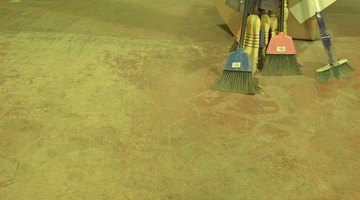How to Install Gypcrete
Contractors install a material called gypcrete as an underlay on floors for sound control and fire protection. Gypcrete is a mixture of gypsum, sand and Portland cement. Installation of gypcrete is done by experienced professionals who level the material over the surface based on the type of subflooring in the room.

Gypcrete can be laid on concrete or wooden boards. After placing in the gypcrete, workers then install the actual flooring on top.
Things You Will Need
- Broom
- Vacuum or portable dry-vac
- Float trowel
- Mixing truck with pump capabilities
- Hoses
- Ventilation and heat equipment
-
Install gypcrete after placing up the drywall. Brush off any dirt, dust or other materials from the floor with the broom. Use a vacuum or portable dry-vac to siphon any particles from the corners of the room.
-
Replace any damaged boards if installing gypcrete on a wood subfloor. Remove doorway baseplates. Mix the gypcrete per instructions for the type you are using. Pump the gypcrete through the hose onto the floor, sweeping the hose in a slow manner so the gypcrete becomes evenly distributed.
-
Pour 1/2 inch of gypcrete onto concrete, or 3/4 inch of gypcrete over tongue-and-groove wooden subfloor with 16-inch to 24-inch truss or beam spacings. Sweep a float trowel over the gypcrete until the floor has an even surface.
-
Allow the gypcrete to fully dry for five to seven days, although you can walk on it after 90 minutes to finish light construction work. Use heating and ventilation equipment to control moisture and supply enough heat for the gypcrete to dry.
The Drip Cap
- Contractors install a material called gypcrete as an underlay on floors for sound control and fire protection.
- Gypcrete is a mixture of gypsum, sand and Portland cement.
- Use a vacuum or portable dry-vac to siphon any particles from the corners of the room.
- Pump the gypcrete through the hose onto the floor, sweeping the hose in a slow manner so the gypcrete becomes evenly distributed.
Writer Bio
Based in southwestern Pennsylvania, Michelle Hickman has written since 2006 on an array of topics including lifestyle, writing instruction and financial services. Her first articles appeared in "The Pittsburgh Tribune Review: Focus Magazine." She holds a certification in computer and information science from Central Westmoreland Career and Technology Center.
Photo Credits
- Hemera Technologies/AbleStock.com/Getty Images
- Hemera Technologies/AbleStock.com/Getty Images
More Articles



